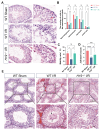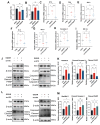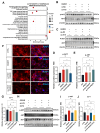Inhibition of LncRNA H19 Attenuates Testicular Torsion-Induced Apoptosis and Preserves Blood-Testis Barrier Integrity
- PMID: 40076761
- PMCID: PMC11899958
- DOI: 10.3390/ijms26052134
Inhibition of LncRNA H19 Attenuates Testicular Torsion-Induced Apoptosis and Preserves Blood-Testis Barrier Integrity
Abstract
Testicular torsion is a common emergency in adolescents, and can lead to severe ischemia reperfusion injury (IRI). LncRNA H19 has been shown to increase during ischemia, but its role in testicular IRI remains unknown. Focusing on this research gap, we utilized H19 biallelic mutant mice and Sertoli cell line (TM4) to construct in vivo and in vitro models of ischemia/reperfusion (I/R) and oxygen-glucose deprivation/reperfusion (OGD/R). Compared to WT I/R mice, H19-/- I/R mice showed milder tissue disorganization and cell loss, with a more intact blood-testis barrier (BTB). The cell viability decreased, ROS levels and apoptosis-related factors such as Bax/Bcl-2 increased in TM4 cells after OGD/R, whereas these changes were reversed when H19 was knocked down followed by OGD/R (si-H19+OGD/R). In contrast, over-expression of H19 in TM4 cells exacerbates OGD/R-induced cell apoptosis. Through in-depth analysis of KEGG-enriched pathways, the PI3K/AKT pathway was identified as a potential target of H19 modulation. Western blotting confirmed that, in OGD/R cells, elevated H19 levels were accompanied by the excessive AKT phosphorylation and the tight junction marker ZO-1 degradation; and in si-H19+OGD/R cells, the decreased AKT phosphorylation was recovered and the up-regulated ZO-1 expression was weakened simultaneously via using the AKT activator SC79. These results suggest that inhibiting H19 in OGD/R cells might preserve the integrity of the BTB by reversing the excessive phosphorylation of AKT. Moreover, H19 deficiency in si-H19+OGD/R cells alleviated the disturbances in glycolysis, fatty acid biosynthesis, and amino acid metabolism. Our study indicates that H19 might be a potential therapeutic target for clinic testicular I/R treatment.
Keywords: Sertoli cell; apoptosis; blood–testis barrier; lncRNA H19; testicular torsion.
Conflict of interest statement
The authors declare no conflicts of interest.
Figures








Similar articles
-
LncRNA H19 Aggravates Cerebral Ischemia/Reperfusion Injury by Functioning as a ceRNA for miR-19a-3p to Target PTEN.Neuroscience. 2020 Jun 15;437:117-129. doi: 10.1016/j.neuroscience.2020.04.020. Epub 2020 Apr 24. Neuroscience. 2020. PMID: 32335212
-
Suppression of lncRNA RMRP ameliorates oxygen-glucose deprivation/re-oxygenation-induced neural cells injury by inhibiting autophagy and PI3K/Akt/mTOR-mediated apoptosis.Biosci Rep. 2019 Jun 25;39(6):BSR20181367. doi: 10.1042/BSR20181367. Print 2019 Jun 28. Biosci Rep. 2019. PMID: 30926681 Free PMC article.
-
LncRNA H19 promotes inflammatory response induced by cerebral ischemia-reperfusion injury through regulating the miR-138-5p-p65 axis.Biochem Cell Biol. 2020 Aug;98(4):525-536. doi: 10.1139/bcb-2019-0281. Biochem Cell Biol. 2020. PMID: 32114772
-
UBIAD1 protects against oxygen-glucose deprivation/reperfusion-induced multiple subcellular organelles injury through PI3K/AKT pathway in N2A cells.J Cell Physiol. 2018 Sep;233(9):7480-7496. doi: 10.1002/jcp.26602. Epub 2018 Apr 16. J Cell Physiol. 2018. PMID: 29663377
-
Panax notoginseng Saponins Protect Cerebral Microvascular Endothelial Cells against Oxygen-Glucose Deprivation/Reperfusion-Induced Barrier Dysfunction via Activation of PI3K/Akt/Nrf2 Antioxidant Signaling Pathway.Molecules. 2018 Oct 26;23(11):2781. doi: 10.3390/molecules23112781. Molecules. 2018. PMID: 30373188 Free PMC article.
References
MeSH terms
Substances
Grants and funding
LinkOut - more resources
Full Text Sources
Research Materials
Miscellaneous

